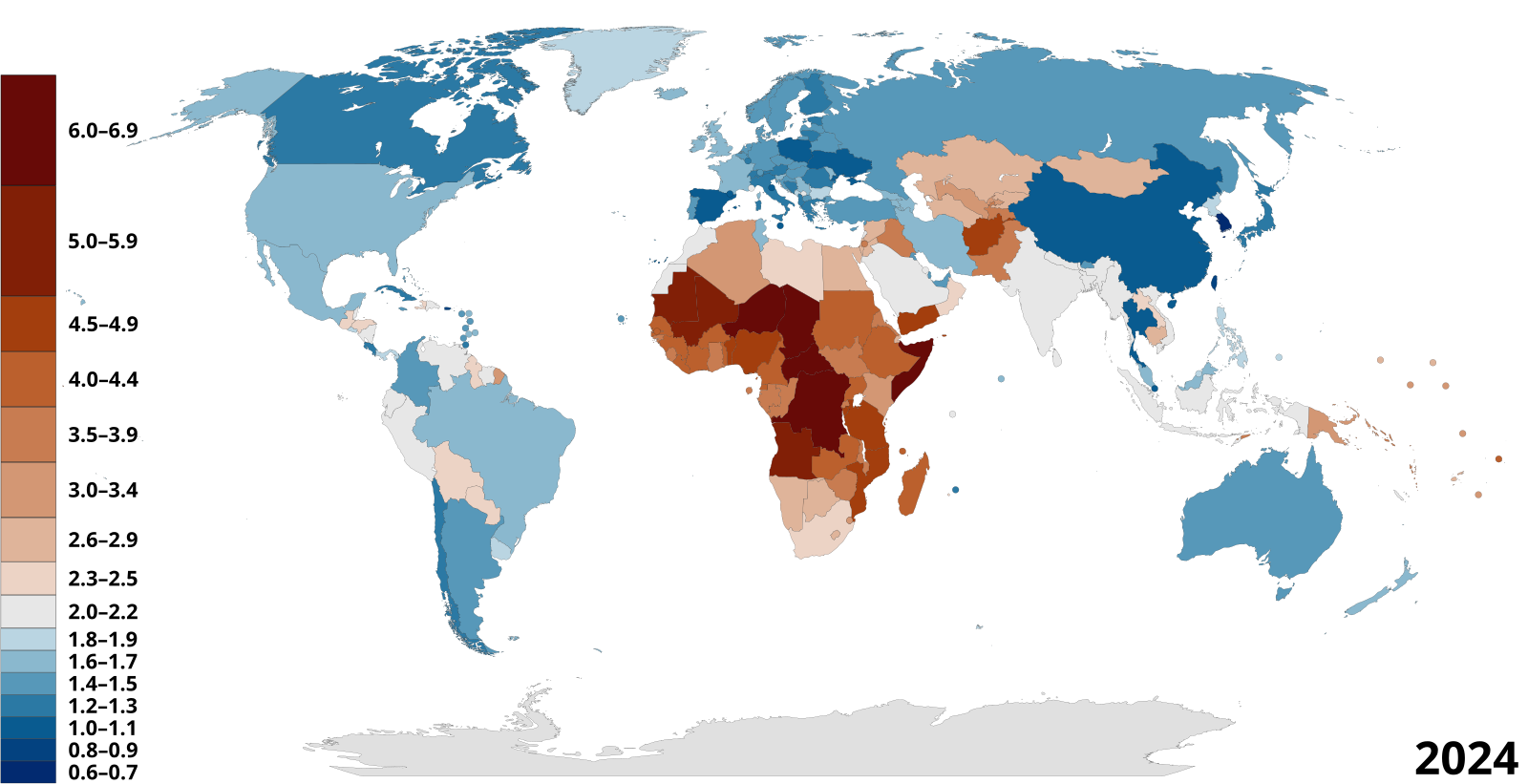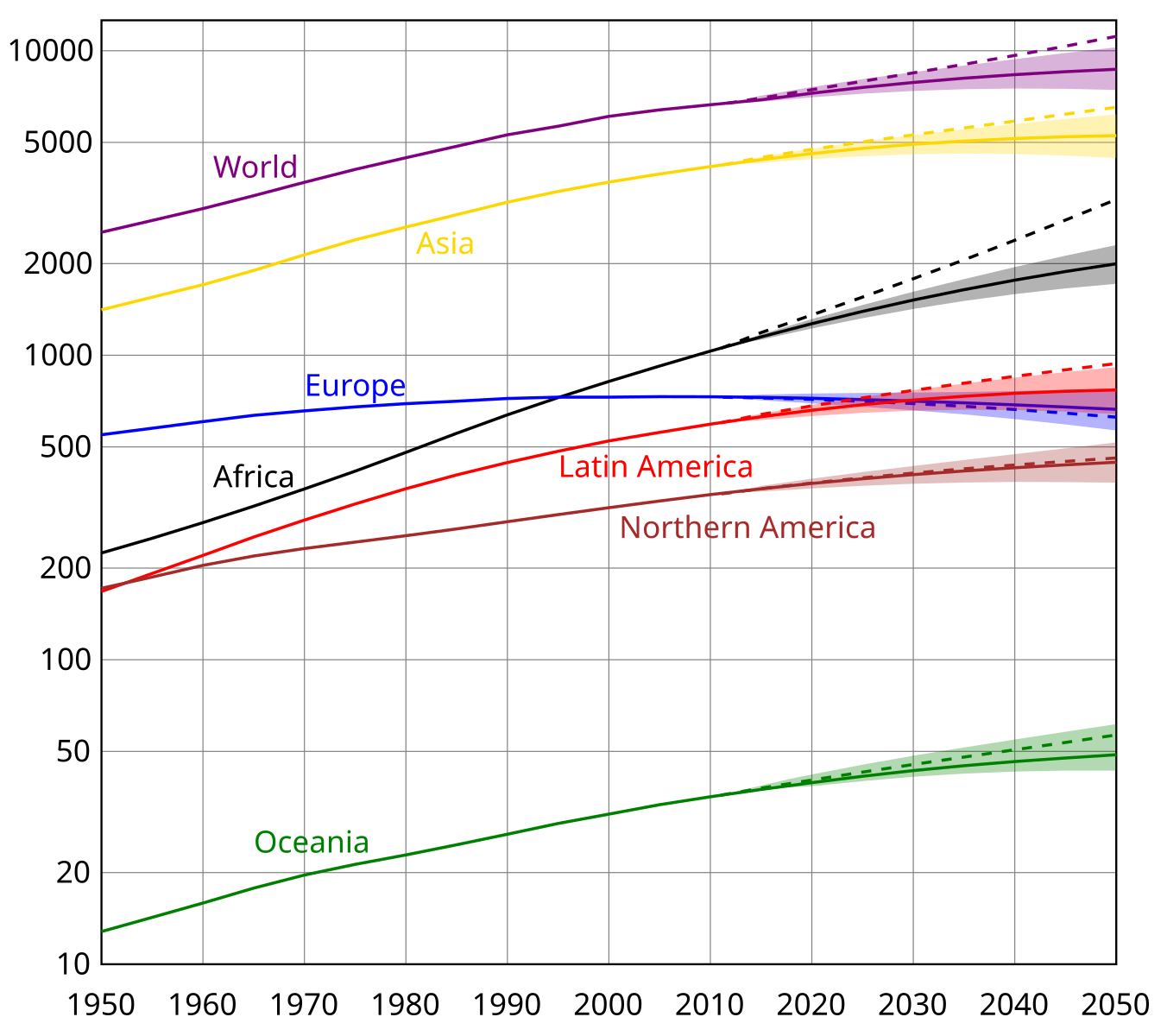IB Syllabus focus:
‘Global population has grown rapidly. UN models project three futures linked to fertility rates, highlighting uncertainty about long-term growth.’
Human population growth is one of the most important drivers of environmental and social change. Understanding global patterns, projections, and their implications is critical in Environmental Systems and Societies.
Historical Context of Global Growth
The global population has experienced unprecedented expansion in the past two centuries. For most of human history, population growth was slow, constrained by high mortality rates, limited food supplies, and disease outbreaks. However, the Industrial Revolution marked a turning point, with improvements in medicine, sanitation, and food production triggering rapid declines in death rates.
Between 1800 and 1900, the global population roughly doubled, rising from around 1 billion to 2 billion. By 2025, the United Nations (UN) projects a world population approaching 8 billion, with much of this growth concentrated in Asia and Africa. This rapid increase has raised profound questions about sustainability, resource use, and the planet’s carrying capacity.
Key Drivers of Global Growth
Fertility Rates
Fertility rate—the average number of children a woman is expected to have in her lifetime—is the most significant factor influencing population change.
Total Fertility Rate (TFR): The average number of live births per woman during her reproductive years, assuming current age-specific fertility rates remain constant.
High fertility rates in regions such as Sub-Saharan Africa sustain rapid population increases.

Choropleth map showing total fertility rate by country, with a clear legend indicating children per woman. The pattern highlights high-fertility clusters in Sub-Saharan Africa and lower fertility in Europe and East Asia, linking regional fertility to long-run growth uncertainty. This visual includes country-level detail that exceeds the syllabus’ global scope but directly illuminates fertility–projection relationships. Source.
Lower fertility rates in Europe and East Asia have led to ageing populations and potential future decline.
Mortality and Life Expectancy
Reductions in infant mortality and increases in life expectancy have boosted population growth. Improvements in public health, nutrition, and access to clean water have driven this trend globally.
Migration
Although less influential at the global scale, migration redistributes populations regionally. For example, urbanisation and international migration alter population dynamics at national and continental levels.
UN Global Projections
The United Nations develops models to predict future population trends based on fertility rate scenarios. These projections are not fixed but illustrate potential pathways.
The Three UN Projections
High Fertility Scenario: Assumes fertility remains higher than expected, leading to continuous and steep population growth. World population could exceed 12 billion by 2100.
Medium Fertility Scenario: Assumes gradual declines in fertility, considered the most likely path. Global population would peak around 10–11 billion by 2100 before stabilising.
Low Fertility Scenario: Assumes rapid declines in fertility. Population could plateau around 7–8 billion and then decline later in the century.
These scenarios highlight uncertainty but also show that small differences in fertility rates can have large long-term impacts.

Line chart of world population with medium-variant projection as a solid line, a shaded band for low–high variants, and a dashed constant-fertility line, illustrating how small fertility differences compound over time. Labels and the legend make variant assumptions explicit. This figure directly supports the syllabus point on UN-modelled futures and uncertainty. Source.
Population Momentum
Even with falling fertility rates, population can continue to grow due to population momentum.
Population Momentum: Continued population growth after fertility rates decline, due to a large proportion of people entering reproductive age.
This phenomenon explains why countries with youthful populations (e.g., Nigeria, India) will likely keep growing even as fertility rates fall.
Demographic Dividends and Challenges
Demographic Dividend
A demographic dividend occurs when the working-age population grows faster than dependents (children and elderly). This creates opportunities for economic growth, as seen in East Asia during the late 20th century.
Demographic Challenges
Ageing populations in Europe and Japan stress healthcare and pension systems.
Youthful populations in Africa and South Asia demand massive investments in education, healthcare, and jobs.
Unbalanced growth can exacerbate inequalities and resource pressure.
Global Growth and Environmental Systems
Population growth directly affects resource use and environmental pressures.
Increased demand for food, water, and energy intensifies pressure on ecosystems.
Urban expansion alters land use and increases pollution.
Larger populations contribute more greenhouse gas emissions, influencing climate change.
These links underline why Environmental Systems and Societies places such emphasis on population dynamics.
Doubling Time and Growth Rates
Population growth can be described mathematically using the rule of 70.
Doubling Time (years) = 70 ÷ Annual Growth Rate (%)
Annual Growth Rate (%) = (Birth Rate – Death Rate) ÷ 10
Birth Rate = Number of births per 1,000 people per year
Death Rate = Number of deaths per 1,000 people per year
This equation helps compare different regions. A country with a growth rate of 2% would double its population in roughly 35 years.
Regional Variations in Growth and Projection
Africa: Projected to be the centre of future growth, with some countries expected to triple in population by 2100.
Asia: Still growing but at a slowing pace; India recently surpassed China as the world’s most populous nation.
Europe: Experiencing population stagnation or decline due to low fertility.
Americas: Slower growth overall, with differences between North and South America.
These differences influence global power dynamics, resource allocation, and environmental impacts.
Implications of Uncertain Growth
The uncertainty surrounding fertility makes long-term projections difficult. Political decisions, cultural shifts, technological developments, and environmental pressures all affect demographic futures. Key areas of concern include:
Global food security.
Urbanisation and infrastructure demands.
Climate change and biodiversity loss.
Social and economic inequalities between regions.
Understanding these factors equips students to critically evaluate the sustainability challenges posed by human population dynamics.
FAQ
Cultural and social factors directly affect fertility trends. In some societies, large families are valued for economic support, inheritance, or tradition, keeping fertility rates higher.
Changing gender roles, improved access to education, and shifting attitudes towards family planning often lower fertility. These cultural shifts can significantly alter long-term projections.
Population growth is cumulative, meaning even a minor variation in the average number of children per woman multiplies across generations.
For example:
A small rise in fertility in a large population (e.g., India) can add hundreds of millions of people by 2100.
A small decline in fertility can slow growth and lead to stabilisation.
This compounding effect explains why projections diverge so widely.
Healthcare advancements reduce infant mortality and extend life expectancy, contributing to overall growth.
Better maternal health services encourage smaller families by lowering child mortality risk.
Vaccination and disease control reduce deaths and sustain population momentum.
Access to reproductive healthcare allows families to choose when and how many children to have.
Sub-Saharan Africa has some of the world’s highest fertility rates and a youthful population structure.
As these large cohorts reach reproductive age, the region’s population momentum will significantly drive global growth trends. If fertility declines more slowly than expected, global population totals could rise much higher than UN medium-variant projections suggest.
Economic development often reduces fertility by changing family priorities.
In wealthier countries, children are seen as a financial cost rather than labour support.
Improved job opportunities for women often delay childbirth.
Rising living standards encourage investment in fewer children with better education and healthcare.
Economic downturns, however, can either reduce births (due to cost) or increase them (in contexts where children provide family security).
Practice Questions
Question 1 (2 marks)
Identify two factors that explain why global population growth projections are uncertain.
Mark Scheme
Fertility rate variations (1 mark)
Differences in mortality rates/life expectancy improvements (1 mark)
Migration patterns may shift projections (1 mark, maximum 2 in total)
Question 2 (5 marks)
Using examples, explain how different fertility rate scenarios influence future global population size according to United Nations projections.
Mark Scheme
High fertility scenario leads to rapid growth, potential exceeding of 12 billion by 2100 (1 mark)
Medium fertility scenario shows gradual stabilisation at around 10–11 billion (1 mark)
Low fertility scenario leads to plateau and potential decline at 7–8 billion (1 mark)
Reference to the role of small differences in fertility having major long-term impacts (1 mark)
Use of relevant example(s), e.g. high fertility in Sub-Saharan Africa or low fertility in Europe/East Asia (1 mark)
Maximum: 5 marks

